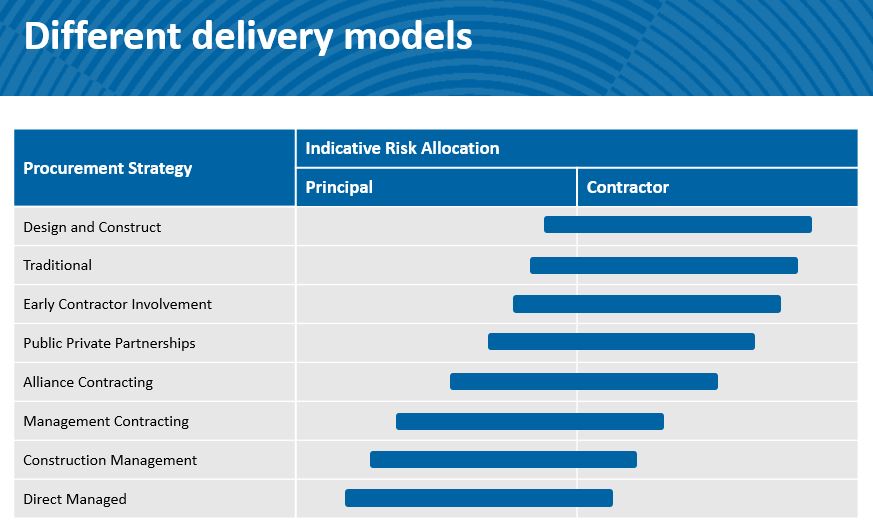
Over the last five years, BRS have seen an increasing use of the Alliance procurement model by client infrastructure delivery agencies. It is a procurement model we are very familiar with having worked as a bid coach and Alliance coach on many alliance projects over the last 12 years in Australia and New Zealand.
- To work through why the Alliance model is currently popular, it worth working through the circumstances that the Alliance model is suited to for a project which are as follows:
- The scope cannot be defined up front as part of the procurement process which makes it hard for the supply chain to provide commercial certainty to the client as part of the tender process;
- There is a high likelihood of scope changes for a variety of reasons particularly around risk allocation and the challenge of the scope not being clearly defined;
- There are numerous complex and/or unpredictable risks that cannot be allocated to the party in the best position to manage the risk. This leads to challenges with pricing and also scope management and certainty;
- Very tight timelines are in play for a variety of reasons. This could be political or there are some critical path activities that require project acceleration;
- There is a need for the client and their supply chain project partners to work closely together to manage challenges and respond effectively when faced with adversity;
- There is increasing complexity and uncertainty associated with the project that requires a shared risk model that ensures all parties are focussed on finding solutions together to these challenges;
- There are shifting business or political imperatives that need to be proactively managed;
- There are significant stakeholder challenges that require a collaborative approach to managing their expectations and project requirements;
- There is a need for owner interference or significant value-adding by owner in the project. There could be significant project history and experience and subject matter experts within the client organisation that needs to be leveraged by the project which the Alliance model allows for through the Owner Interface Manager (OIM) role and function; and
- Threats and/or opportunities that can only be managed collectively by all parties can be managed proactively through the Alliance procurement model with a focus on solutions and working as one team.
All the elements above link back to the concept of the Alliance model being a shared risk model. This is in contrast to other procurement models which can be demonstrated through the following diagram:

The point that this diagram supports is that any project needs to go through an appropriate risk allocation and multi-criteria analysis to ensure that the project is aligned to the right procurement model. It does not mean that one procurement model is better than another but it does ensure there is an appropriate link between your risk allocation process and the procurement model that will help you best manage this.
Subsequently, the benefits to the client of the Alliance model are as follows:
- Much greater certainty of on-time or early delivery, especially in the face of adversity due to the fact that all parties are in the Alliance together and given the risks are collectively shared all parties are incentivised to drive towards outstanding outcomes;
- The project in the right circumstances has the opportunity to be delivered very close to or under the agreed Target Cost. This is subject to ensuring that a high performing Alliance is developed and everyone is working as one team;
- More informed decisions on technical solutions and the choice of equipment due to the fact that all parties are working together to make best for project decisions. This should lead to better outcomes for the project;
- Better balance between capital investment and whole-of-life costs as the Alliance normally has the luxury of working through a whole of life approach to decisions but also the operation and management of the service or asset post the Alliance period;
- Outcomes that meet or exceed expectations in non-cost areas through the use of Key Result Areas (KRAs) / Key Performance Indicators (KPIs) that drive the right behaviours of the Alliance. This is a real feature of the Alliance model in incentivising non-owner participants of the Alliance to drive outstanding outcomes;
- Potential for real breakthroughs in some areas due to everyone working as one team to drive outstanding outcomes. This is particularly relevant of programme alliances where you have the luxury of making step changes in areas such as design, technical input and other key areas specific to your project;
- Much greater job satisfaction / professional development for all people involved in the Alliance. Due to the collaborative nature of the Alliance model, it tends to build a constructive culture which attracts and retains staff;
- Alignment of commercial interests – no time wasted arguing with each other as there is an open book approach to the financials at the establishment phase of the Alliance which provides transparency and openness to the commercials on the project;
- Collaborative management / synergy through everyone working as one team under the Alliance model. The Alliance leadership model is not hierarchical which means the best people are put in various roles to make sure the leadership is effective on the Alliance;
- Elimination of duplication – no person-marking or duplicated systems due to the fact that the Alliance has one set of systems and processes that are best for Alliance selected from all parties involved in the Alliance;
- Faster decision-making given the Alliance model has its own governance structure. This allows for speed and autonomy of decision making which is critical on projects;
- Increased innovation;
- Greater realisation / exploitation of opportunities on projects due to the shared risk allocation and commercial model enabling this to occur easily without contractual or governance constraints; and
- Better / more holistic risk management through collective and aligned strategies to manage inherent risks and external threats through the shared risk model approach.
I am agnostic around one procurement model being better than others. I think each procurement model should be chosen appropriately based on the scope and criteria of a project and the above risk allocation model. However, there is no doubt in my eyes that with the increasing challenges around political, governance, stakeholder and other risks, the Alliance model is seen as a potential solution to managing these risks collectively by all parties involved.
if you would like to undertake Alliance 101 training with your team or require alliance coaching support, please go to the following link – Commercial Acumen Training for Owners | BRS (brsresults.com)



